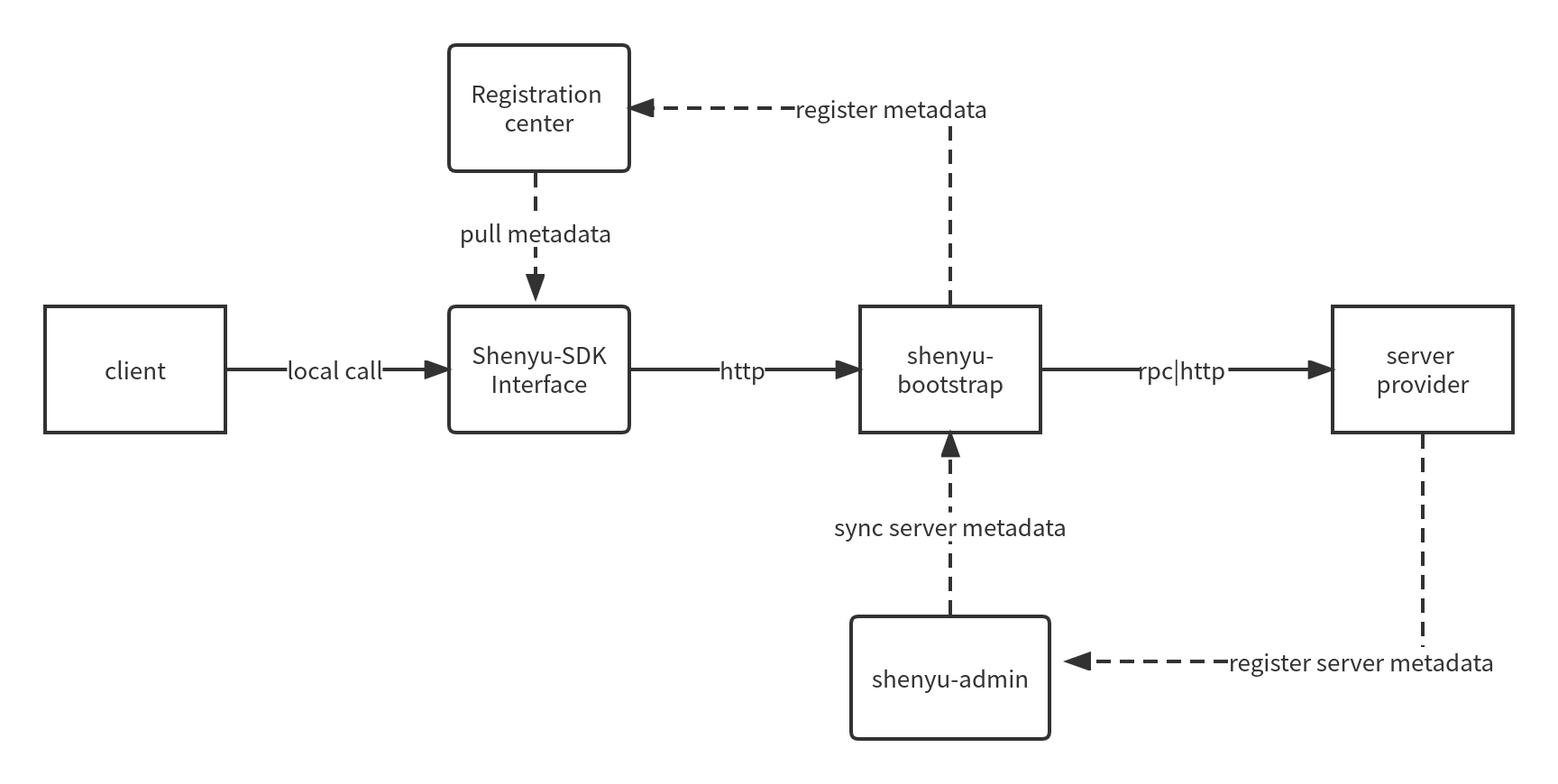Using Nacos with Shenyu-SDK
Background explanation
Shenyu offers Shenyu-Sdk to make it easy for services to quickly integrate with the Shenyu gateway. By simply depending on the SDK and doing some simple configuration, client services can call the gateway's exposed APIs as if they were calling local interfaces.

The registration center supported by the gateway for client access includes (nacos, eureka, etcd, zookeeper, consul), and the following is the relevant guide for using nacos registration center when shenyu-bootstrap and application client are used.
Environment preparation
Refer to Deployment guide, and choose a way to start shenyu-admin and shenyu-bootstrap.
shenyu-bootstrap
Maven dependency
In the gateway's pom.xml file, introduce the following dependencies.
<dependency>
<groupId>org.apache.shenyu</groupId>
<artifactId>shenyu-spring-boot-starter-registry</artifactId>
<version>${project.version}</version>
</dependency>
Edit the configuration file
Add the following configuration to the gateway's yml configuration file.
spring:
application:
name: shenyu-bootstrap
cloud:
discovery:
enabled: true
nacos:
discovery:
server-addr: 127.0.0.1:8848 # Enter the nacos address(es), separated by commas in English.
enabled: true
namespace: ShenyuRegisterCenter # nacos namespace ID
# if nacos authentication is enabled, the following parameters must be configured
username: nacos # Authentication username
password: nacos # Authentication password
Client Application
Maven dependency
In the pom.xml file of the application client, introduce the following dependencies.
- Shenyu-Sdk Core
<dependencies>
<dependency>
<groupId>org.apache.shenyu</groupId>
<artifactId>shenyu-sdk-core</artifactId>
<version>2.5.1-SNAPSHOT</version>
</dependency>
<dependency>
<groupId>org.apache.shenyu</groupId>
<artifactId>shenyu-spring-boot-starter-sdk</artifactId>
<version>2.5.1-SNAPSHOT</version>
</dependency>
</dependencies>
- Shenyu-Sdk http implementation
HTTP client implementation, offering okhttp and httpclient as implementation options. Other implementations can be created by extending the
AbstractShenyuSdkClientclass.
<!-- httpclient -->
<dependency>
<groupId>org.apache.shenyu</groupId>
<artifactId>shenyu-sdk-httpclient</artifactId>
<version>2.5.1-SNAPSHOT</version>
</dependency>
<!-- okhttp -->
<!--
<dependency>
<groupId>org.apache.shenyu</groupId>
<artifactId>shenyu-sdk-okhttp</artifactId>
<version>2.5.1-SNAPSHOT</version>
</dependency>
-->
Edit the configuration file
Add the following configuration in the application client's yml configuration file.
shenyu:
sdk:
enabled: true
register-type: nacos
server-lists: localhost:2181
props:
nacosNameSpace: ShenyuRegisterCenter
username: nacos
password: nacos
retry:
enable: true
period: 100
maxPeriod: 1000
maxAttempts: 5
algorithm: roundRobin
scheme: http
# registerType: service registration type, fill in nacos.
# serverList: Enter the nacos address(es), separated by commas in English.
# nacosNameSpace: nacos namespace ID
# username: Authentication username
# password: Authentication password
# scheme: Request protocol.
# retry: Configuration related to failure retries.
# retry.period: Retry waiting time.
# retry.maxPeriod: Maximum retry waiting time .
# retry.maxAttempts: Maximum retry count.
Writing the local interface for the SDK
-
In the project startup class, annotate
@EnableShenyuClients(basePackages = "org.apache.shenyu.examples.sdk.http.api"), wherebasePackagesmaintains the package location of Shenyu-Sdk's corresponding maintained gateway API interface. -
Create an interface and use the
@ShenyuClient(name = "xxx", contextId = "ShenyuSdkApiName")annotation to mark it, wherenamerepresents the gateway service name. If you need to define multiple beans to maintain the gateway's API, you can usecontextIdas the corresponding bean alias. -
In the defined interface, add the methods of the interface to be mapped to the shenyu gateway, where the
valueof@xxMappingcorresponds to the path of the corresponding request in the gateway.
Example
Project startup class
import org.apache.shenyu.sdk.spring.EnableShenyuClients;
@SpringBootApplication
@EnableShenyuClients(basePackages = "org.apache.shenyu.examples.sdk.http.api")
public class ShenyuSdkHttpExampleApplication {
/**
* main.
*
* @param args args
*/
public static void main(final String[] args) {
SpringApplication.run(ShenyuSdkHttpExampleApplication.class, args);
}
}
Shenyu-SDK interface
import org.apache.shenyu.sdk.spring.ShenyuClient;
@ShenyuClient(name = "shenyu-bootstrap", contextId = "ShenyuSdkApiName")
public interface ShenyuHttpClientApi {
/**
* findById.
* test Get.
*
* @param id id
* @return SdkTestDto
*/
@GetMapping("/http/shenyu/client/findById")
SdkTestDto findById(@RequestParam("id") String id);
}
For more information, refer to the sample project shenyu-examples-sdk